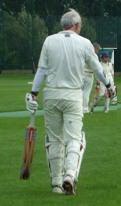
Fantasy Bob is confident that all 3 members of his world wide readership are familiar with the thinking of the eminent psychoanalyst Carl Jung.
Less probably they maybe familiar with the fifth and final album released by popular music ensemble Police in 1983.
Either way he is sure that they will understand the concept of synchronicity. Jung invented the term to describe what he called 'temporally coincident occurrences of a-causal events'. FB's readers may pause there to reflect that to the extent they understand this phrase it seems to describe perfectly FB's attempts to play leg spin bowling.
However they might move on from this trifling observation to reflect that the term embodies the idea that the conceptual relationship of minds and ideas is intricately structured and gives rise to relationships that are not causal but appear meaningfully related. It gives pattern and meaning to our experience individually and collectively.
FB had a heavy dose of synchronicity this week.
He and Mrs FB found themselves in the Welsh seaside resort of Colwyn Bay. The dense fog and biting wind were not conducive to sightseeing, not that Colwyn Bay offers much to the sightseer; far less a day on the beach, for Colwyn Bay beach is closed while it is being rebuilt.
They therefore repaired to a small tearoom. Having got over the disappointment of not finding empire biscuits in the cake selection, they engaged the proprietor in conversation. He acknowledged his failure in the empire biscuits department but attributed this to the fact that he was deeply engaged in the local controversy surrounding the town's pier which the Council is planning to demolish. There is a furious local campaign against this proposal; among other things FB learned that this act of civic vandalism would remove not only the focal point of the town's sea front but a listed building containing murals by artist Eric Ravilious.
FB and Mrs FB nodded sympathetically. As residents of Edinburgh they are unfamiliar with the concept of civic authorities acting unwisely.
As they reengaged with the biting wind outside FB and Mrs FB held their heads down not only for protection against the cold, but to hide their shame that the name of this artist was unfamiliar to them.
 |
| Eric Ravilious |
Ravilious was celebrated not only for his landscapes, inspired by the Sussex Downs, but also for book illustrations, engraving and woodcuts. He was commissioned as a war artist in 1939 and tragically died in 1942 when the plane he was flying in went missing- while it was searching for another lost plane in Iceland. More synchronicity?
As if all this is not enough to satisfy the seeker after synchronicity, FB further discovers that Ravilious is the creator of one of the most familiar images known to cricketers. Although only an occasional cricketer himself (he reported once that in a village match he hit three sixes, writing breathlessly as FB might have, “It is, you might say, one of the pleasures of life, hitting a six.” But FB has never hit 3 sixes.) Ravilious was commissioned in 1938 to produce the engraving that still graces the cover of Wisden.
And Ravilious' other work is well worth looking at too.
All this synchronicity has given FB a headache and he needs to lie down.
 |
| The Wilmington Giant by Eric Ravilious. |
*The Old Ways by Robert Macfarlane



No comments:
Post a Comment